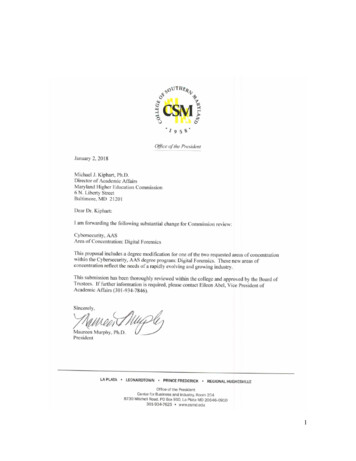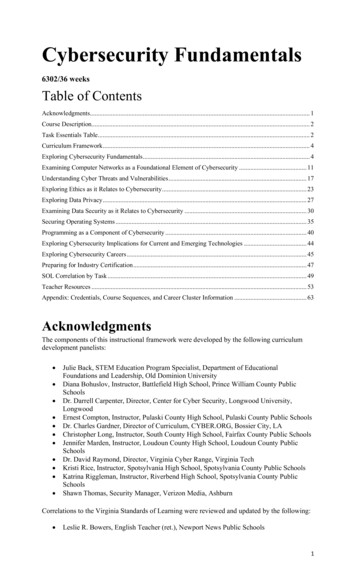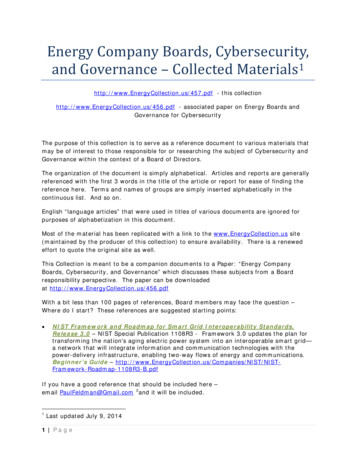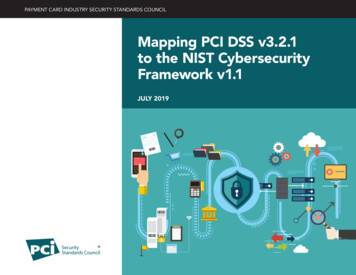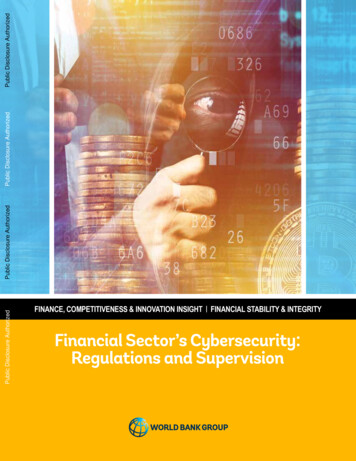
Transcription
Public Disclosure AuthorizedPublic Disclosure AuthorizedPublic Disclosure AuthorizedPublic Disclosure AuthorizedFINANCE, COMPETITIVENESS & INNOVATION INSIGHT FINANCIAL STABILITY & INTEGRITYFinancial Sector’s Cybersecurity:Regulations and Supervision
2018 The World Bank Group1818 H Street NWWashington, DC 20433Telephone: 202-473-1000Internet: www.worldbank.orgAll rights reserved.This volume is a product of the staff of the World Bank Group. The World Bank Group refersto the member institutions of the World Bank Group: The World Bank (International Bank forReconstruction and Development); International Finance Corporation (IFC); and MultilateralInvestment Guarantee Agency (MIGA), which are separate and distinct legal entities eachorganized under its respective Articles of Agreement. We encourage use for educational and noncommercial purposes.The findings, interpretations, and conclusions expressed in this volume do not necessarily reflectthe views of the Directors or Executive Directors of the respective institutions of the World BankGroup or the governments they represent. The World Bank Group does not guarantee the accuracyof the data included in this work.Rights and PermissionsThe material in this publication is copyrighted. Copying and/or transmitting portions or all ofthis work without permission may be a violation of applicable law. The World Bank encouragesdissemination of its work and will normally grant permission to reproduce portions of the workpromptly.All queries on rights and licenses, including subsidiary rights, should be addressed to the Officeof the Publisher, The World Bank Group, 1818 H Street NW, Washington, DC 20433, USA;fax: 202-522-2422; e-mail: pubrights@worldbank.org.
FINANCE, COMPETITIVENESS & INNOVATION INSIGHT FINANCIAL STABILITY & INTEGRITYTABLE OF CONTENTSACRONYMS AND ABBREVIATIONSIIIACKNOWLEDGMENTSVINTRODUCTION1I. ARE CYBER-SPECIFIC REGULATIONS NECESSARY?3II. COORDINATION AMONG AUTHORITIES5III. MANDATORY REPORTING AND INFORMATION SHARING7IV. RESPONSIBILITIES OF THE BOARD11V. RESPONSIBILITIES OF SENIOR MANAGEMENT13VI. INFORMATION SECURITY OFFICER15VII. INCIDENT RESPONSE17VIII. TESTS AND SIMULATIONS19IX. OUTSOURCING21X. SUPERVISION23XI. CONCLUDING REMARKS25REFERENCES27FINANCIAL SECTOR’S CYBERSECURITY: REGULATIONS AND SUPERVISIONI
IIIII. MANDATORY REPORTING AND INFORMATION SHARING
FINANCE, COMPETITIVENESS & INNOVATION INSIGHT FINANCIAL STABILITY & INTEGRITYACRONYMS AND ABBREVIATIONSAICPAAmerican Institute of Certified Public AccountantsAPIsApplication Programming InterfacesASICAustralian Securities and Investment CommissionBaFinGerman Federal Financial Supervisory AuthorityBCBSBasel Committee on Banking SupervisionCAPECCommon Attack Pattern Enumeration and Classification(MITRE Corporation)CCDCOECooperative Cyber Defence Centre of ExcellenceCCICommonwealth Cybercrime InitiativeCERTComputer Emergency Response TeamCISOChief Information Security OfficerCPMICommittee on Payments and Market InfrastructuresCSIRTComputer Security Incident Response TeamCTOCommonwealth Telecommunications OrganisationCybOXCyber Observable ExpressionDDoSDistributed Denial of ServiceEBAEuropean Banking AuthorityENISAEuropean Union Agency for Network and Information SecurityEUEuropean UnionFDICFederal Deposit Insurance CorporationFinSACFinancial Sector Advisory CenterFMIFinancial Market InfrastructureFRBFederal Reserve BoardG7Group of 7GCSCCGlobal Cyber Security Capacity Centre (University of Oxford)GCSPGeneva Centre for Security PolicyIaaSInfrastructure as a ServiceICTInformation and Communications TechnologyIECInternational Electrotechnical CommissionFINANCIAL SECTOR’S CYBERSECURITY: REGULATIONS AND SUPERVISIONIII
IVIOSCOInternational Organisation of Securities CommissionsISACInformation Sharing Analysis CenterISOInternational Organization for StandardizationITInformation TechnologyITUInternational Telecommunication UnionNATONorth Atlantic Treaty OrganizationNISTNational Institute of Standards and TechnologyNYSDFSNew York State Department of Financial ServicesOASOrganization of American StatesOCCOffice of the Comptroller of the CurrencyOECDOrganisation for Economic Co-operation and DevelopmentPaaSPlatform as a ServiceSaaSSoftware as a ServiceSOCSystem and Organization ControlsSTIXStructured Threat Information ExpressionTAXIITrusted Automated Exchange of Indicator InformationUNCTADUnited Nations Conference on Trade and DevelopmentVCDBVERIS Community Database (Verizon)VERISVocabulary for Event Recording and Incident Sharing (Verizon)ACRONYMS AND ABBREVIATIONS
FINANCE, COMPETITIVENESS & INNOVATION INSIGHT FINANCIAL STABILITY & INTEGRITYACKNOWLEDGMENTSThe author, Aquiles A. Almansi, is a Lead Financial Sector Specialist, Finance, Competitiveness &Innovation Global Practice at the World Bank Group (WBG). This paper draws on the backgroundwork of Dror (2017), Nelson (2017) and Taylor (2017). Detailed comments were received,although not necessarily reflected in this draft, from Dorothee Delort (Senior Financial SectorSpecialist), Katia D’Hulster (Lead Financial Sector Specialist), Miquel Dijkman (Lead FinancialSector Specialist), Pasquale Di Benedetta (Senior Financial Sector Specialist), Valeria SalomaoGarcia (Senior Financial Sector Specialist), Damodaran Krishnamurti (Lead Financial SectorSpecialist), Harish Natarajan (Lead Financial Sector Specialist), Sang Man Park (Senior FinancialSector Specialist) - all of the Finance, Competitiveness & Innovation Global Practice - as well asIveta Zdravkova Lohovska (Consultant, Information Technology Services, WBG), Sandra Sargent(Senior Operations Officer, Digital Development and Transport, WBG), Zhijun William Zhang(Senior Information Technology Officer, Information Technology Services, WBG), Claus Sengler(European Central Bank), Paul Williams (Bank of England), and Rui Lin Ong (Monetary Authorityof Singapore).A special thanks goes to Aichin Lim Jones (Graphic Designer) for her work on the graphics designof this publication.FINANCIAL SECTOR’S CYBERSECURITY: REGULATIONS AND SUPERVISIONV
VIACKNOWLEDGMENTS
FINANCE, COMPETITIVENESS & INNOVATION INSIGHT FINANCIAL STABILITY & INTEGRITYINTRODUCTIONAccording to the Group of 7 (G7) (2016), cybersecurity risks to the global financial systemare of critical concern. Attacks on cyberspace, that is, the space between interconnectedcomputers, are “increasing in sophistication, frequency, and persistence, [and] cyber risksare growing more dangerous and diverse, threatening to disrupt our interconnected global financialsystems and the institutions that operate and support those systems.” Similarly, the InternationalOrganisation of Securities Commissions (IOSCO) (2016) has “recognized that cyber riskconstitutes a growing and significant threat to the integrity, efficiency and soundness of financialmarkets worldwide.” Compounding the problem, the inexorable trend toward exclusive digitalcustomer interactions increases the financial sector’s exposure to cyber risks. In this context,PricewaterhouseCoopers (PwC) (2017) notes that 46 percent of bank customers are already digitalonly, compared with 27 percent in 2012. Furthermore, those customers interacting with bank staffcontinue to shrink, falling from 15 to 10 percent during the same period.IBM X-Force Research (2017) reveals that thefinancial services sector was attacked more thanany other industry in 2016, with the averagefinancial institution monitored by IBM SecurityServices experiencing 65 percent more attacks thanthe average client organization across all industries.Moreover, there was a 29 percent increase in attacksfrom 2015.1 In this context, distributed denial ofservice (DDoS) and ransomware attacks disruptedthe provision of financial services in severalcountries. Money was stolen or confidential data“exfiltrated” (leaked) using other types of malwareand “social engineering” tricks.“Cyber risk,” frequently narrowly understood asthe occurrence of intentional or malicious “cyberincidents,” is just one of the many things that can gowrong in the world of interconnected computers.2Information and Communications Technology(ICT) risk, in turn, is traditionally understood asjust one class of operational risk, a tradition that12could suggest some questionable analogies withother classes of such risk.To deal with the problem, several leadingjurisdictions have issued or proposed detailed laws,regulations or guidelines dealing with cyber riskor, more generally, ICT risk. The World Bank’sFinancial Sector Advisory Center (FinSAC) (2017)has compiled and continuously updates a digestof this quickly growing body of regulatory andadvisory work.The G7 (2016) sees the following fundamentalelements “as the building blocks upon which anentity can design and implement its cybersecuritystrategy and operating framework”: governance,risk assessment, monitoring, response, recovery,information sharing, and continuous learning.This paper presents the main ideas that can be foundwidely represented in the FinSAC’s CybersecurityFor detailed analyses and statistics about cyber incidents, see also Symantec (2017), Synoptek (2017), and Verizon (2017aand 2017b).In addition to intentional incidents, incidents can occur accidentally due to faulty processes, or for purely technical reasons. For a discussion of the many things that can go accidentally wrong due to software complexity, see Somers (2017).FINANCIAL SECTOR’S CYBERSECURITY: REGULATIONS AND SUPERVISION1
Regulations in the Financial Sector (2017), whichcoincides with those of the G7’s fundamentalelements. It also outlines attempts to identify theemerging consensus on practices to implementregulations, as well as on how to supervise theirimplementation by individual financial institutions.The paper is organized as follows: Section I brieflypresents some different viewpoints with regardto the need for financial institutions to write newregulations. Section II discusses the necessarycoordination between financial sector authoritiesand other state agencies in the regulation andsupervision of the sector’s ICT systems. Section IIIpresents sample taxonomies (languages) used bydifferent parties to talk about cyber “risks” and shareinformation on cyber “incidents”. Sections IV, V,and VI outline, respectively, the responsibilities ofthe Board, senior management and, if the positionexists, the Information Security Officer. SectionVII discusses incident response and recovery.Section VIII describes practices regarding tests andsimulations. Section IX addresses the increasinglycritical issue of outsourcing. Section X presentssample guidelines for supervisors, and section XIcontains concluding remarks.2INTRODUCTIONThe mandatory or suggested practices identifiedin this paper are those of primary interest for thefinancial sector authorities in charge of regulatingand/or supervising licensed banking and nonbanking institutions. As more dimensions ofthe provision of financial services migrateto the space of interconnected computers (or“cyberspace”), other state and regional agencies— such as European Union Agency for Networkand Information Security (ENISA), and nationalsecurity agencies in some jurisdictions — will beregulating how operations are to be conducted intheir respective domains. This implies that financialinstitutions in some jurisdictions will have to abideby a growing number of regulations pertainingto technical ICT matters beyond the regulatoryperimeter of the financial sector authorities, suchas encryption protocols, application programminginterfaces (APIs), or authentication mechanisms.These are outside the scope of this paper.While the provisional findings of this work aresignificantly enhanced by the FSB stocktaking ofexisting regulations and supervisory practices inG20 jurisdictions presented last October, financialsector authorities from World Bank client countries,in search of guidance on whether and how toregulate and supervise cyber risk management ininstitutions subject to their jurisdiction, may findthe main ideas here described a good starting point.
FINANCE, COMPETITIVENESS & INNOVATION INSIGHT FINANCIAL STABILITY & INTEGRITYI. ARE CYBER-SPECIFICREGULATIONS NECESSARY?Crisanto and Prenio (2017) note that there are differing institutional views about whetherand how to regulate cyber risks. “One view is that the evolving nature of cyber risk isnot amenable to specific regulation and that cyber issues can be handled with existingregulations relating to technology and/or operational risk. The other view is that [a] regulatorystructure is needed to deal with the unique nature of cyber risk, and given the growing threatsresulting from an increasingly digitized financial sector.”Commenting on the United States Federal ReserveBoard/ Office of the Comptroller of the Currency/Federal Deposit Insurance Corporation (FRB/OCC/FDIC) advanced notice of proposed rulemaking onenhanced cyber risk management standards (2016),Promontory (2017) notes that a “rulemaking thatimposed overlapping new cybersecurity standardson top of the multiple existing standards, withoutany empirical analysis of actual effects, wouldbe counterproductive. Rather than improvingcybersecurity, such a rulemaking would divertto unproductive compliance processes the veryresources that covered entities could otherwisedevote to securing operations.” In this context,Crisanto and Prenio (2017) note that one “potentialbenefit of regulation is that it can help ensure Boardand Management buy-in. As regulation makes anyissue more visible to Boards and Management,regulation on cyber risk gives banks a strongerincentive to continuously invest in improvedcybersecurity.”Promontory points out the multiple, overlapping,international cybersecurity standards such as theInternational Organization for Standardization(ISO)/ International Electrotechnical Commission(IEC) 27000 (2016), ISO/IEC-27001 (2005), ISO/IEC-27002 (2013), the System and OrganizationControls (SOC) for Cybersecurity of the AmericanInstitute of Certified Public Accountants (AICPA)3,3frameworks such as the one from the NationalInstitute of Standards and Technology (NIST)(2017 and 2014), as well as guidelines likethose of the Committee on Payments and MarketInfrastructures (CPMI-IOSCO) (2016), andregulations on operational risk management inmost national jurisdictions.Management failures occur because too manypeople still see cybersecurity as a technical matter,reserved for the exclusive domain of informationtechnology (IT) specialists. As Crisanto andPrenio (2017) suggest, regulations that actuallydeal mostly with corporate governance mattersmake cybersecurity more visible to Boards andManagement, thereby providing stronger incentivesto them to take responsibility for it.Traditional ways of thinking about operational risk,incorporated in some regulations on cyber risk, maynot be fully adequate to deal with the new reality.Principle 25 of the Basel Committee on BankingSupervision (BCBS) (2012), for example, includesamong its essential criteria the provision that “Thesupervisor requires banks’ strategies, policies andprocesses for the management of operational risk(including the banks’ risk appetite for operationalrisk) to be approved and regularly reviewed bythe banks’ Boards.” However, given the systemicmagnitude of cybersecurity risk derived from ve.aspxFINANCIAL SECTOR’S CYBERSECURITY: REGULATIONS AND SUPERVISION3
system’s interconnected nature, it is unclear whythe degree of cyber risk taken by an individualinstitution should depend in any sense on theBoard’s risk “appetite” for operational risk. Thepresence of negative externalities would suggestsetting minimum standards regardless of such“appetite,” or any other subjective consideration.4Technical complexity (in the number of potentialentry points for an attacker and in the diversity of454services), the capacity to deal with it, and the potentialsystemic impact of cyber incidents are likely to beproportional to the size of the financial institution.As such, some of the emerging guidelines andregulations fully apply to large institutions only.5Since an interconnected system is as strong as theweakest of its nodes, some jurisdictions may wellchoose to consider subjecting all interconnectedinstitutions to the same minimum cybersecuritystandards, regardless of size.For example, the average delay in departures, and the proportion of luggage lost, could indeed be left to an airline’s “riskappetite,” but the frequency of crashes probably should not.Standards set forth by the FRB-OCC-FDIC (2016), for example, would apply to all U.S. bank holding companies with totalconsolidated assets of 50 billion or more.I. ARE CYBER-SPECIFIC REGULATIONS NECESSARY?
FINANCE, COMPETITIVENESS & INNOVATION INSIGHT FINANCIAL STABILITY & INTEGRITYII. COORDINATIONAMONG AUTHORITIES“.each distinct aspect of cybersecurity ( cyber crime, intelligence, military issues,Internet governance, or national crisis management) operates in its own silo, belonging,for instance, to a specific government department or ministry. Each of these silos has itsown technical realities, policy solutions, and even philosophies.”Principle 2 of the BCBS (2012) requires the banksupervisor to possess “operational independence”,and the first essential criteria for the observanceof such a principle requires that “no governmentor industry interference . compromises theoperational independence of the supervisor,”and that the “supervisor has full discretion totake any supervisory actions or decisions onbanks and banking groups under its supervision.”These requirements are fully consistent with thesupervision of managerial behaviors. However,the regulation and supervision of ICT risks, aswell as the response to incidents, may require theintervention of other state agencies.Many countries have already published nationalcybersecurity strategies, frequently identifyingthe state agencies in charge of setting minimumstandards and responding to a cyber incident.References to bank security can already be foundin the following country strategies: Australia,Austria, Bangladesh, Brunei Darussalam, Canada,China, Colombia, the Arab Republic of Egypt,France, Ghana, Ireland, Italy, Japan, Jordan, Kenya,Malaysia, Micronesia, Morocco, the Netherlands,New Zealand, Nigeria, Norway, Poland, Qatar,the Russian Federation, Saudi Arabia, Singapore,Slovakia, Slovenia, Sweden, Switzerland, the67Klimburg (2017)United Kingdom (UK), and the United States(US).6 National cybersecurity strategies and legalframeworks should clearly specify the respectiveresponsibilities of the financial sector and otherauthorities, such as national security agencies.Without such clarity, jurisdictional conflicts arebound to arise when issuing new cybersecurityregulations or, even worse, when handling cyberincidents in the financial sector.7A new reference guide is being developed by ahost of organizations to serve as a single source toguide countries in developing their own nationalcybersecurity strategies. This guide should also helpfinancial sector authorities better understand thenature of the institutional structure required to dealwith cybersecurity. It is currently being preparedby the International Telecommunication Union(ITU), a United Nations agency, in partnershipwith the Commonwealth Cybercrime Initiative(CCI), the Commonwealth TelecommunicationsOrganisation (CTO), ENISA, the Geneva Centrefor Security Policy (GCSP), the University ofOxford’s Global Cyber Security Capacity Centre(GCSCC), Intellium, Microsoft, the North AtlanticTreaty Organization (NATO)’s CooperativeCyber Defence Centre of Excellence (CCDCOE),the Organisation for Economic ityAn important example of a legal framework that clarifies the roles of different state agencies is EU (2016), naturally including cross-border considerations in the European UnionFINANCIAL SECTOR’S CYBERSECURITY: REGULATIONS AND SUPERVISION5
and Development (OECD), the Organization ofAmerican States (OAS), the Potomac Institute,RAND Europe, the United Nations Conference onTrade and Development (UNCTAD) and the WorldBank.6II. COORDINATION AMONG AUTHORITIES
FINANCE, COMPETITIVENESS & INNOVATION INSIGHT FINANCIAL STABILITY & INTEGRITYIII. MANDATORY REPORTINGAND INFORMATION SHARINGPrevious sections assume a common understanding of what is meant by words such as“cyber”, “risks” and “incidents,” as used by the G7 (2016), the International Organisationof Securities Commissions (IOSCO) (2016) and IBM (2017), among others. To understandhow different organizations utilize these terms requires knowing their respective “taxonomies”(languages) is required. All stakeholders need precise, common languages to share information,either of the mandatory kind, between supervisory institutions and authorities or, to prevent thespread of cyber incidents, voluntarily with other potentially affected entities.Taxonomies are languages or conventions forinformation sharing, and there are many of them.For instance, ICT specialists frequently work withMITRE Corporation’s “Common Attack PatternEnumeration and Classification” (CAPEC), a“comprehensive dictionary and classificationtaxonomy of known attacks that can be used byanalysts, developers, testers, and educators toadvance community understanding and enhancedefenses”.8 Regarding mechanisms of attack,CAPEC identifies 118 different mechanisms tocollect and analyze information; 152 to injectunexpected items;156 to engage in deceptiveinteractions; 172 to manipulate timing and state;210 to abuse existing functionality; 223 that employprobabilistic techniques; 225 that subvert accesscontrol; 255 that manipulate data structures; and262 that manipulate system resources. Regardingdomains of attack, CAPEC identifies 403 differenttypes of social engineering; 437 on the supplychain; 512 on communications; 513 on software;514 on physical security; and 515 on hardware.Verizon offers the “Vocabulary for EventRecording and Incident Sharing” (VERIS) to helporganizations “collect and share useful incidentrelated information anonymously and responsibly.”989101112VERIS is a set of metrics designed to provide acommon language for describing security incidentsin a structured and repeatable manner, namely: the“who” (threat actors), the “what” (victim assets),the “why” (threat motives), and the “how” (threatactions) of each cybersecurity incident.10. TheVERIS Community Database (VCDB) is an openand free repository of publicly-reported securityincidents in VERIS format.11Another taxonomy available for the automatedsharing (primarily among computer systems,not among people!) of threat information instandardized format was originally developed bythe US Department of Homeland Security. It iscurrently maintained by an open community12,and is composed of the freely available TrustedAutomated Exchange of Indicator Information(TAXII), the Cyber Observable Expression(CybOX), and the Structured Threat InformationExpression (STIX).Apart from highly specialized units in financialsupervisory agencies, none of these taxonomiesare likely to be very useful for information sharingamong financial sector authorities, or betweenthem and the Boards and Senior Management ofCAPEC: Common Attack Pattern Enumeration and Classification—A Community Resource for Identifying and Understanding Attacks, https://capec.mitre.org/.“Veris: The Vocabulary for Event Recording and Incident Sharing” at: http://veriscommunity.net.“Vocabulary for Event Recording and Incident Sharing” at: https://github.com/vz-risk/veris.VCDB raw data is available at: https://github.com/vz-risk/VCDBOasis Cyber Threat Intelligence” at: https://wiki.oasis-open.org/cti/.FINANCIAL SECTOR’S CYBERSECURITY: REGULATIONS AND SUPERVISION7
supervised institutions. In this context, the EuropeanBanking Authority (EBA) (2017), for example,asks European bank supervisors to map identifiedICT risks into the following five risk categories: Availability and continuity risk: the risk thatthe performance and availability of systemsand data are adversely impacted, including theinability to timely recover due to a failure ofhardware or software, management weaknesses,or any other event. Data integrity risk: the risk that data storedand processed are incomplete, inaccurate orinconsistent across different systems. Change risk: the risk arising from the inabilityof the institution to manage system changes in atimely and controlled manner. Outsourcing risk: the risk that engaging athird party, or another group entity (intra-groupoutsourcing), to provide systems or relatedservices, adversely impacts the institution’sperformance and risk management. Security risk: the risk of unauthorized access tosystems from within or outside the institution.Data integrity, and services availability andcontinuity are some of the dimensions that may,for many different reasons, go awry with theICT systems of a financial institution. In otherwords, services can be disrupted and/or datacompromised. Physical and logical (“bugs”) canimpact ICT systems, and institutions can fail toproperly manage the constantly changing state oftheir ICT systems,13, and/or the external providersof outsourced services. Additionally, ICT systemscan fail because of security reasons, that is, whensomeone from inside or outside the institutionintentionally does something that disrupts servicesor affects data integrity.13148The EBA’s first four “ICT risks” remain, at leastconceptually, reasonably well defined over time,but “security” risks keep mutating. As illustrated bythe CAPEC taxonomy, there are literally thousandsof ways (by combining different “domains” and“mechanisms” of attack) that a financial institution’sICT systems can be compromised. Attacks canoccur without penetrating ICT systems; or bypenetrating them with or without hacking them; byinsiders or a variety of outsiders; with or without“social engineering”; with or without physicalaccess to them — and many more ways yet to bediscovered.Once an incident has affected the ICT systems ofa supervised institution, EBA’s taxonomy providesa language to communicate possible answers asto what has happened (services disrupted and/ordata integrity affected?) and why it has happened(autonomous system malfunction, or inadequatemanagement of own and/or third-party systems,and/or malicious third-party intervention?).Although only some supervisory agencies mayhave the internal capacity to make productive useof strictly technical information, as described forexample by the taxonomies of CAPEC or TAXIICybOX-STIX, all supervisors need a taxonomy todescribe the impacts of an incident. Once again,EBA offers a helpful taxonomy of the possibleimpacts of an incident, as follows:14 Financial impact including (but not limitedto) loss of funds or assets, potential customercompensation, legal and remediation costs,contractual damages, lost revenue; Business disruption, considering (but not limitedto) the criticality of the financial services affected;the number of customers and/or branches andemployees potentially affected; Reputational impact based on the criticalityof the banking service or operational activityThe state of ICT systems keeps changing because, in addition to new applications or new features in existing ones, theyconstantly undergo security updates. Any of these changes can break a system at any time.To understand the essentially linguistic (conventional) role of all taxonomies, these impacts are what other parties wouldperhaps prefer to call the risks associated to an ICT incident.III. MANDATORY REPORTING AND INFORMATION SHARING
affected (e.g., theft of customer data); the externalprofile/visibility of the ICT systems and servicesaffected (e.g. mobile or on-line banking systems,point of sale, ATMs or payment systems); Regulatory impact, including the potential forpublic censure by the regulator, fines or evenvariation of permissions; and Strategic impact, if strategic products or businessplans are compromised or stolen.Supervisory taxonomies facilitate informationsharing among supervisors, and between themand supervised institutions. Given the potentialregulatory impact, however, supervised institutionshave limited incentives to voluntarily reportincidents. Consequently, some jurisdictions makesuch reporting mandatory. The European Union(EU) (2016), for example, regulates the mandatorynotification of a significant incident as follows:“Banking corporations shall notify, withoutundue delay, the competent authority ofincidents having a significant impact onthe continuity of the essential servicesthey provide, or in case that there is areasonable likelihood of materially harmingbusiness operations. Notifications shallinclude information enabling the competentauthority to determine any impact of theincident. Notification shall not make thenotifying party subject to increased liability.”Furthermore, it specifies the followingparameters as determining the magnitude ofthe impact: “(a) the number of users affectedby the disruption of the essential service;(b) the duration of the incident; and (c) thegeographical spread with regard to the areaaffected by the incident.”15It is important to note that in addition to establishinga mandatory reporting requirement, the EU (2016)states its precise purpose (to enable the competentauthority to determine any impact of the incident),and it also defines how to account for such animpact. Without stating the precise purpose of thenotification, in many countries the supervisoryauthority could easily become liable for whatit does — or does not do — in responding to anincident. As suggested in section II, respondingto an incident is likely to eventually become theresponsibility of other state agencies, such as aComputer Emergency Response Team (CERT)o
III FINANCIAL SECTOR'S CYBERSECURITY: REGULATIONS AND SUPERVISION ACRONYMS AND ABBREVIATIONS AICPA American Institute of Certified PublicAccountants APIs Application Programming Interfaces ASIC Australian Securities and Investment Commission BaFin German Federal Financial Supervisory Authority BCBS Basel Committee on Banking Supervision CAPEC Common Attack Pattern Enumeration and Classification

